A Statement of Purpose is not something you write often. May be you’re not even a good writer generally.
What if I tell you there’s a simple but effective formula that you can use to craft a compelling graduate school SOP?
Well, we’ve analyzed several SoPs that won acceptance to the top universities in the world and come up with a formula to write one.
In this article, we analyze an SOP that helped the applicant get into Biomedical engineering PhD programs at MIT and was also accepted at Stanford and Georgia Tech.
For the record, the SOP was freely and generously shared by the applicant on Twitter (bless him!) with the hope that it helps anyone applying.
Full credit therefore to the author.
We’re now offering one-on-one expert guidance on how to write a statement of purpose. This is in addition to our reviewing, editing, and standardizing services. Check out our ordering page, fill out the required details and let us help you craft a statement of purpose that will flood your email with admission offers.
phdstatementsofpurpose.com
(Other MIT samples: MIT and University of Washington Accepted Statement of Purpose for PhD in Computer Science)
Side Note: Does your recommender need a guide/sample? We have created this for him/her
Letters of Recommendation: A Necessary Guide and Sample

The Biomedical Engineering Statement of Purpose
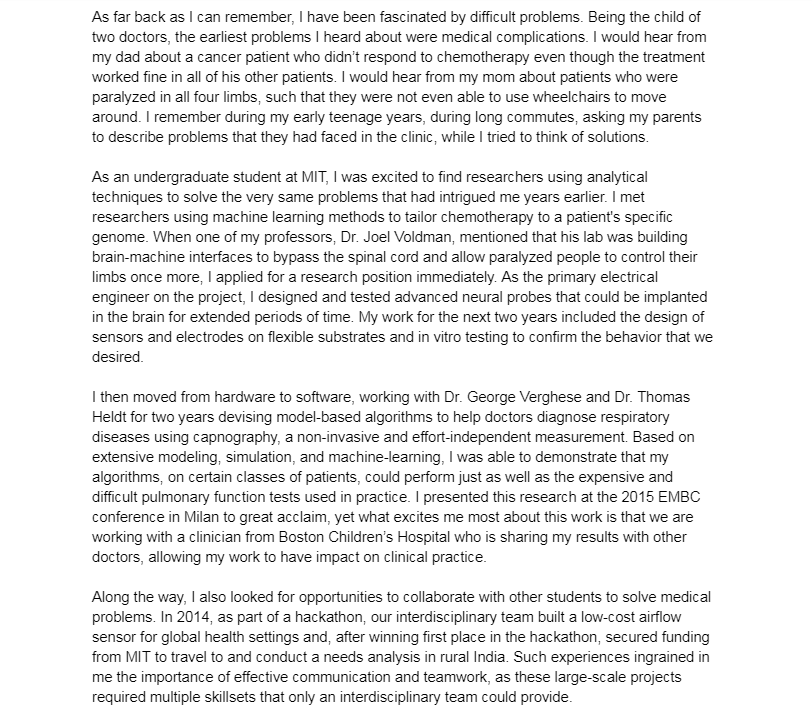
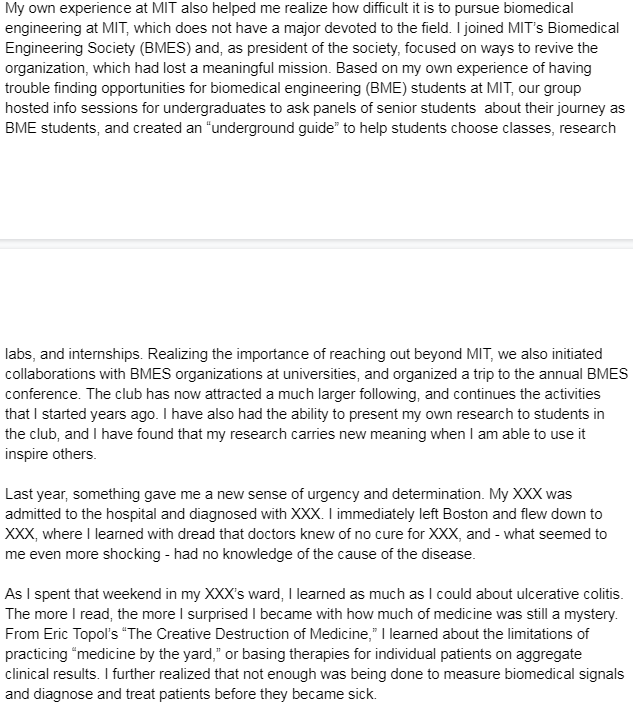
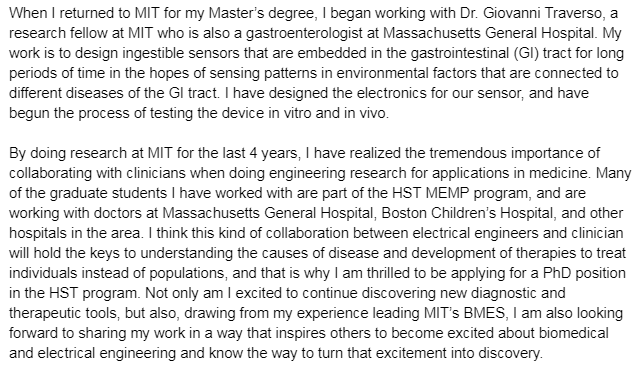
In analyzing this SOP, we’ll be focusing on the structure and style used.
Structure
A careful read of this SOP shows that it’s rendered in a discernible structure that contains an introduction, body, and conclusion. This makes it highly readable, which is important given that the admission committees receive and evaluate many SOPs.
We’ve observed the following structure:
- Introduction
- Research experience
- Teaching/volunteering/related experience
- Why this program, why now
- What next
- Conclusion
Introduction
The SOP starts by tracing/describing the applicant’s interest in the field of study.
He has always been fascinated by difficult problems, which, combined with natural curiosity and parents who were doctors, led him to pursue a course that would involve solving challenging problems.
From our experience reviewing more than a thousand SOPs, we find that a personal story is one of the most compelling ways of starting a SOP.
Some pundits argue that childhood/personal stories have become very common and won’t excite the admission panel. It doesn’t appear to have harmed this particular applicant and there’s no reason not to use it.
However, we have also observed some COMMON MISTAKES with this type of introductory narratives.
One, some applicants exaggerate events and therefore put off the admission panel. Try to be as credible as possible.
Second, some applicants fail to connect their personal story to their interest in the field of study. Relevance is vital.
Writer’s Comment
An alternative method to craft your introduction is to articulate a broad statement of goals.
This may be in the form of a rhetorical question or a brief exploration of your research interest and what you intend to find out.
You may also describe something that you do not understand in this field, or a problem that is yet to be solved.
The Nursing Statement of Purpose in this LINK has used a series of questions and broad statement of research goals as the introductory narrative.
It’s recommendable that the last line of the introduction be a sentence articulating your ultimate goal of pursuing the program.
The Body
The introductory framework seamlessly transitions to the body in which the applicant describes his background/qualifications for the program chronologically and intellectually.
From our reading, the applicant has applied part of the formula that we generally use to review SOPs, which we have found to be highly effective:
- What did you do?
- Whom did you collaborate with?
- How did you do it?
- What was the result/outcome?
- What did you learn from it (technical aspects as well as soft skills such as team work and communication)
- What’s the application/use of what you found out?
- How will this program build on that?
Research Experience
Notice how the second and third paragraphs are devoted to explaining the kind of research the applicant engaged in, the researchers he worked with, his role and achievements, and lastly publication and its impact.
We’ve noticed that the applicant describes his experience in a way that is common with highly successful SOPs.
He describes the experience, accomplishments, and collaboration.
Notably, the achievements and outcomes of his research experiences are stated with concrete achievements including awards and publications.
Example: “I designed and tested advanced neural probes that could be implanted in the brain for extended periods of time.”
Moreover, the experiences have been quantified.
This means that if you worked with a number of students, state how many they were.
The applicant has also described actions as opposed to just stating the change in emotional state.
Strong action verbs have been used. They include:
- I designed
- I tested
- Devised
- Presented
- Collaborated
- Secured
Which other action verbs can you see in the SOP?
As you’ll notice, these verbs make the difference between a vague experience and a concrete one.
More examples are provided here:
Vague experience: During the project, I was excited to learn that neural probes could be implanted for longer than previously thought.
Concrete experience: I collaborated with clinicians to design and test neural probes that could be implanted on the brain to bypass the spinal cord for paralyzed people.
Vague experience: I showed initiative and leadership in the lab research.
Concrete experience: Disappointed with the pace of the project, I proposed a new project that was readily accepted by the team.
Vague experience: I won the best master’s student research.
Concrete experience: I won the biomedical department’s prize for top research among my cohort of 120 students.
Successful Statements of purpose do not just state the experience; they also explain the meaning of these experiences.
In explaining the experiences, the applicant answers the question of “why” and “so what”.
How for instance was the experience relevant and important to your growth in this field?
Rather than just stating that you were the president or leader of your cohort, explain the leadership skills that you developed and how they helped your academic and professional journey.
In the SOP we’re analyzing here, notice how the applicant explains his presidency of the Biomedical Engineering Society. He explains his role in reviving the organization and the role it played in mentoring undergraduate students and seeking collaborative opportunities.
Other related experience
Within the body of the SOP, the fourth and fifth paragraphs have been dedicated to describing non-research experiences.
Ideally, this section should delve into teaching, volunteer, professional, or any other related experience.
The applicant focuses on non-academic experience, specifically leadership and collaboration.
Notice the concrete description of experiences in the paragraph where he describes a hackathon he was part of. He states its mission, outcome/achievement, and skills learned.
In the next paragraph, he delves into his leadership experience. Again, he uses concrete and quantifiable experiences and explains his roles and achievements as a leader.
While applying for graduate school, it is important that your SOP underscores not just your academic experience but other skills that will help you to become a successful candidate.
Remember that you’ll be joining a team and the supervisors want to be assured that you have the right personality to work as part of a team.
Research Gap/Agenda
Having described his experiences, the applicant now moves to answer a very important question: What do you want to do, who you want to do with, and why.
The approach he has taken is to highlight a gap in research. From the experience of sick relative, he realized that the traditional practice of medicine has its limitations as it’s made for populations and not customized for the individual.
There was therefore need for therapeutic treatment that was customized to one’s genome.
So what’s the way forward? Work with clinicians to understand the cause of diseases and develop therapies.
Compelling? Yes.
The applicant has identified a research problem that holds a lot of promise.
Explain your qualification.
In the Sop, the applicant has explained his work during his Master’s degree and connected this with his research interests.
Match for the Program
The applicant demonstrates not just an understanding of the program but also knowledge of some of the members.
He has already worked with some graduate students as part of the university program, which alludes to the fact that he’s an insider who’d immediately settle in.
This shows not just that the program is suitable for him but also how suitable he is for the program.
We observe that the applicant has dedicated little space to describe how he is a match for the program.
We reckon that having been a student at MIT already, and having described his various research and engagements with the university, he has already covered enough to show how the program is a match for him.
Ordinarily, the following approach would help you write this section:
This approach is also recommended by MIT
- Visit the program’s website and familiarize yourself with the requirements and language used. Try to echo the requirements and language. If the program lists certain objectives, describe how you fit into each.
- If you have access to any member of the faculty, get in touch with them and discuss the program. In writing about your suitability, capture these interactions while describing why you are a good match.
- Research about professors in the program of interest and find those whose work aligns with your background and goals. Briefly describe the research area while paying close attention to the directions your own may take.
Comment on fit with an advisor
Someone who has worked with an adcom of a top Uni wrote on ‘Behind the Scenes in PhD Admissions’:
“Fit with an advisor is extremely important, as their interests will be in mind during initial passes over all applications. If you make it to later rounds, they’ll likely be the one directly advocating for your admission.”
We can’t emphasize this enough.
The expert further cautions that a short SOP that’s poorly written is treated as a red flag.
Career goals
The applicant clearly states his career goal, which, as an biomedical engineer, is to work with clinicians to understand the causes of diseases and create individualized therapies.
He demonstrates an acute understanding of where he wants his career to go and the people he’d work with to achieve this goal.
From our experience, a clearly stated career goal section helps the admission panel know that you know what you want. It also helps them determine if the program will help you or not.
It’s therefore recommendable that your goals are Specific, Measurable, Achievable, Realistic, and Time-bound.
Mention the organizations or people you’d like to work with.
However, even as you make your goals achievable and realistic, they must address a big human problem.
Universities invest a lot of money to train and educate their students. If you don’t have a plan to solve a big human problem, they may not consider you worthy of admission.
Conclusion
The applicant concludes by stating that he’s thrilled to be applying for a PhD position to continue discovering new diagnostic and therapeutic tools.
He restates his leadership experience and links it to his future goal of inspiring others to venture into the same field to discover new things.
From our experience reviewing statements of purpose, we find this concluding formula to be highly effective.
One of the most common questions applicants ask when writing their SoPs is: How do I conclude my statement of purpose?
We find this formula effective:
In the future, I plan to work in (state your organization or industry) and contribute to solving (state a particular problem). The PhD/Ms Program will make this possible by (restate the objectives of the program)
Step by Step analysis of the SoP
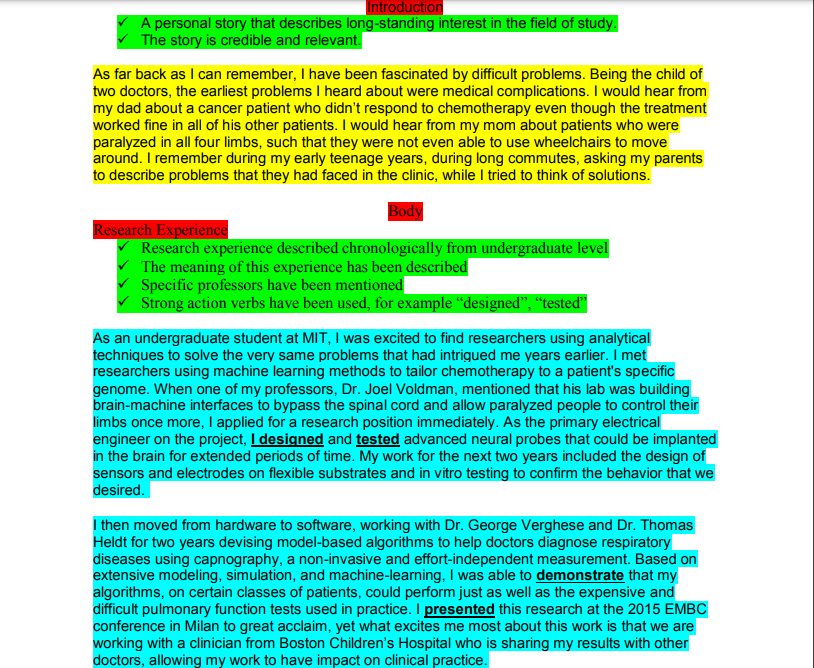
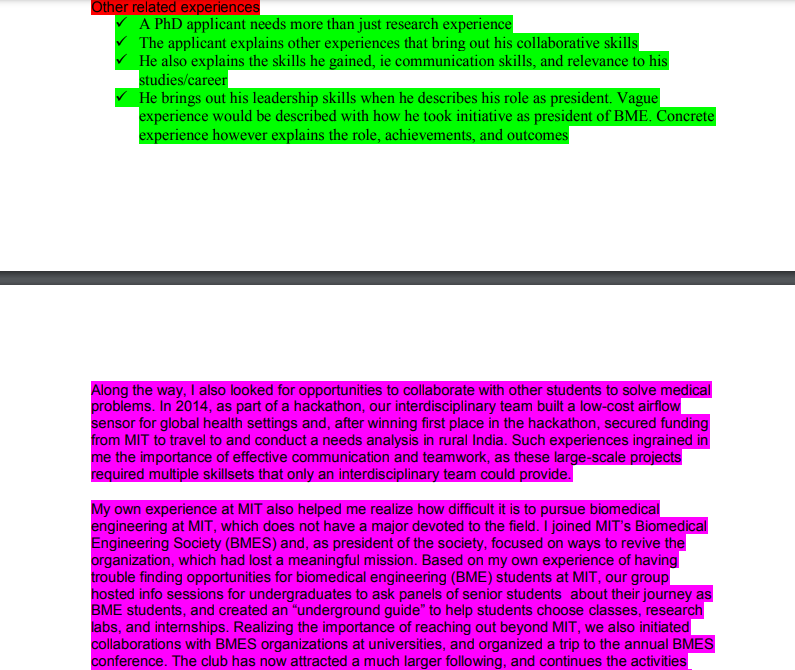
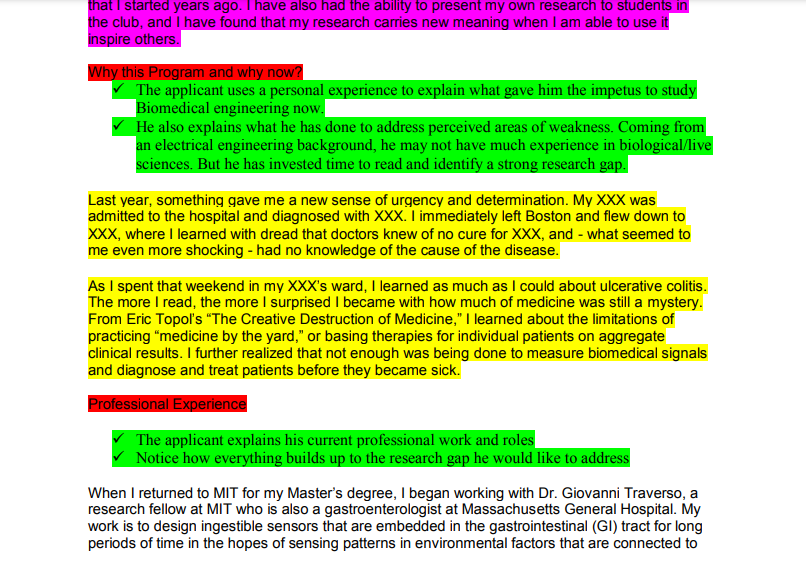
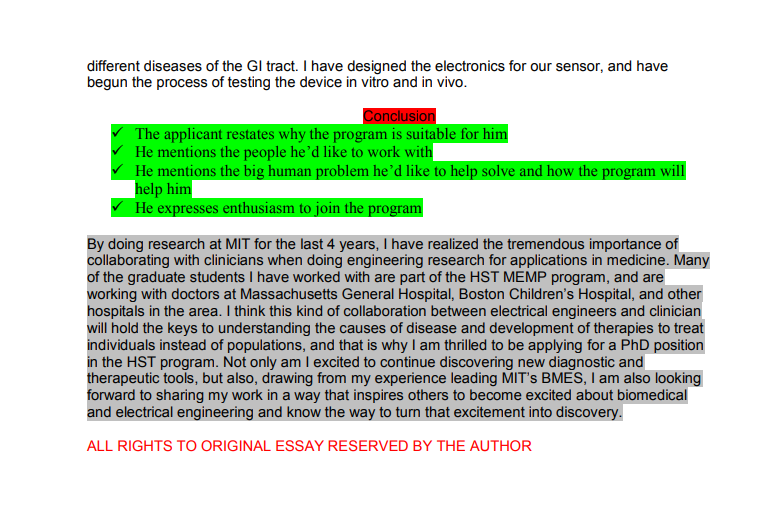
Style of Writing
We’ve covered the simple but effective structure used to write this SoP but there’s something else that makes it unique.
One of the most asked questions regards the style one should use in writing their SoP.
Should it be written in a matter of fact manner?
Should it be written in a personal or formal tone?
A SoP should be written in formal style that is nonetheless free of jargon.
You’ll notice that the applicant is an electrical engineer applying to a biomedical engineering program, both of which are esoteric subjects.
However, even if your background is in tourism, hospitality, or marketing, you’d still understand what the applicant’s qualifications and goals are.
Jargons tend to undermine readability and if you can avoid them the better.
The Story-telling behind the SOP
Obama, Martin Luther King jr., Winston Churchill..
What do they have in common?
The three are/were powerful orators who mesmerized their audience with their oratory prowess.
The three are/were also compelling story tellers who held their audience captive.
Story telling is one of the most powerful means of persuading and convincing people.
In SoP writing, a story telling approach helps you to connect with the evaluating panel.
It helps them feel familiar to you. They feel that they can trust you.
Good stories also stick. A story telling approach makes your SoP memorable.
What else do we learn from the SOP?
When applying for a program that cuts across one or more areas of study, you may find that you are inadequate in some areas in terms of not having covered certain courses.
A biomedical program at MIT for instance requires courses in multiple areas of sciences such as biology, chemistry, and technology.
So how do you explain when you’ve fulfilled the course requirements in one are but not the other?
We reckon that this is the essence of paragraph 8 in this particular SOP.
The applicant explains that he has invested significant time reading books to cover areas where he may have inadequacies.
We’ve found it an effective strategy to admit areas of background concern and follow it with a commitment to address them.
The example below:
“I recognize that I only have minimal training in XXX, so the amount of coursework and reading I will have to do is significant. I however find this exciting rather than an obstacle since it is vital for my success as an YYY, which I desperately desire.”
Conclusion
To recap, the simple but effective formula used to write this SOP can be summarized as follows:
| Introductory narrative | -1 or 2 paragraphs -Can be a personal/childhood story -Can be a broad statement of goals -Must be credible and relevant |
| Body | -Description of research experience in 1 or 2 paragraphs -Description of other experiences (volunteer, teaching, leadership) in 1 or 2 paragraphs -Research gap/interest (what is it and why now) in 1 paragraph -Why this program in 1 paragraph – Career goals in 1 paragraph |
| Conclusion | -Restate future goals -State the big human problem you want to solve -State how the program will help you solve the problem -Last sentence should express enthusiasm to join the program |
Final word
It’s always recommendable to have someone go through your SoP before you submit it.
A friend or a family member can help to tell whether you’ve represented yourself credibly and compellingly enough.
A professor or a faculty member may also help to tell whether you’ve captured your academic and research background well enough and connected them to your research interests and suitability for the program.
At phdstatementsofpurpose.com, we are that friend and faculty member.
After reviewing thousands of SoPs and personal statements, we can tell a good from a not so good SoP, and a good one from a great one.
We’ve internalized the structure and language of writing SoPs and with our team of experts; we’ll sit down and dissect your draft.
We’ll point out areas of strengths and weaknesses and propose how to structure and express your SoP better.
We’ll give intense and detailed feedback so that you express your thoughts with clarity and bring out your uniqueness.
We’ll ensure that the final product is delivered in time, is logical and coherent, intellectual, and polished.
Tell us which aspect of your SoP writing you’re struggling with:
How to start?
How to conclude?
Written your SoP but you’re unsure whether it meets high enough standards?
Check out our PACKAGES and get in touch.
That’s not all
We’ve got a few more Statements of Purpose samples and guides that you can read and use for free
Statement of Purpose for Mathematics sample and guide
Ivy School MBA Statement of Purpose sample and guide
Statement of Purpose sample and guide for Business Management
Statement of Purpose sample and guide for MPH and MBA with engineering background
Statement of Purpose sample for Nursing undergraduate
Statement of purpose sample and guide for computer science
The Complete UK Universities Guide for International Students
Follow us on social media:
Facebook @Phdstatementsofpurpose
Twitter @PhDstatements
Tiktok @statementsofpurpose
[learn_press_profile]

